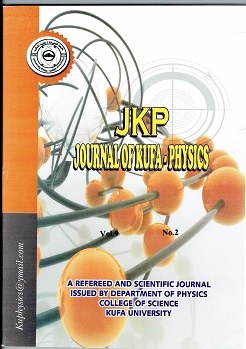Physical Properties and Transmitted Sunlight of Polyvinyl Chloride/ZnO Nanocomposites Films
DOI:
https://doi.org/10.31257/2018/JKP/2022/140203Abstract
The optical properties of polyvinyl chloride (PVC) and PVC/Zinc Oxide (ZnO) films were considered with different amounts of ZnONPs (0.001, 0.002, 0.003, 0.004 and 0.005) g. Using a Tetrahydrofuran (THF) solution all films be prepared by casting method. XRD results showed the amorphous structure of PVC film and Hexagonal crystalline structure of ZnO NPs, PVC/ZnO nanocomposites appear as pattern of PVC films so the peaks of ZnO don’t appear in it. FESEM image of PVC, ZnO and structure of PVC/ZnO nanocomposites seems to have cluster aggregates in different size. FTIR spectra revealed that ZnONPs had no effect on the polymer structure as there are no covalent bonds between PVC and ZnO NPs. Increasing the amounts of ZnONPs was seen to improve the optical properties (Absorbance, absorption coefficient and extinction coefficient) for PVC polymer. PVC polymer transmittance and energy gap decreased from 5.25 eV to 4.98 eV with increasing the amounts of ZnO NPs in nanocomposites. The solar radiation intensity in Baghdad was measured at a rate of 1 hour for the pure PVC films and PVC/ZnONPs for seven consecutive days in a rate from 6 A.M. to 6 P.M. (13 h). As can be observed, all films have the same ratio of transmitted radiation strength to sunlight intensity for all hours and days.
Downloads
Downloads
Published
How to Cite
Issue
Section
Categories
License
Copyright (c) 2023 Hussein Ali, Mahasin F. Hadi Al- Kadhemy, Asrar Abdulmunem Saeed

This work is licensed under a Creative Commons Attribution 4.0 International License.
Journal of Kufa-Physics is licensed under the Creative Commons Attribution 4.0 International License, which allows users to copy, to create extracts, abstracts, and new works from the Article, to alter and revise the Article, and to make commercial use of the Article (including reuse and/or resale of the Article by commercial entities), provided the user gives appropriate credit (with a link to the formal publication through the relevant DOI), provides a link to the license, indicates if changes were made and the licensor is not represented as endorsing the use made of the work. The authors hold the copyright for their published work on the JKP website, while KJP is responsible for appreciating citation for their work, which is released under CC-BY-4.0 enabling the unrestricted use, distribution, and reproduction of an article in any medium, provided that the original work is properly cited.













